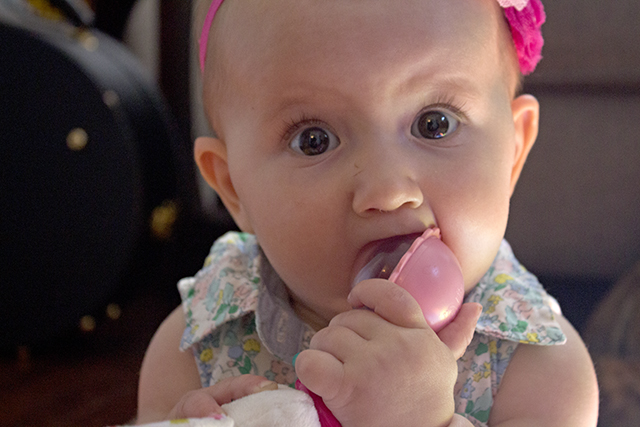Skip the Jars and Pouches: How to Make Your Own Baby Food and Save Money

Just like any major life event, having a child is presented as a time (or an excuse) to spend money.
You need the latest this, the greatest that — and everything in between.
In reality, a great deal of this stuff is unnecessary, and you can get tons of it at a heavy discount or even for free.
One potential area to save is on baby food. While those little jars are adorable and the pouches are super convenient, you pay a premium for the cuteness and ease of use.
Homemade baby food can be much more economical — and it’s not even that hard to make. And as an added bonus, you know exactly what your child is eating.
How to Save Money With Homemade Baby Food
House Mix blogger Kate did the math. She calculated one serving of high-quality, store-bought baby food adds up to 60 cents per serving.
“Canned baby food is the same price per ounce no matter the flavor, whereas the price of produce varies greatly,” Kate says.
She found banana was the most economical homemade baby food, coming in at 12 cents per serving. Most homemade options range from about 14 cents per serving for carrots to 39 cents for apples.
Only one variety of homemade food, for which Kate chooses organic ingredients, comes in slightly more expensive than the pre-made varieties. Surprisingly, green beans work out to be 62 cents per serving when made at home.
But when Kate ads up her baby food expenses at the end of the month, it’s still far cheaper to make food at home for her daughter, Clara.
“I found that it costs about $8.30 to feed her [each] week if I make her food from organic produce,” Kate says. “It would cost $16.66 if I bought organic food jars. That is a savings of 50 percent.”
With savings like that, it seems worth a try.
Here are tips and tricks from thrifty parents around the web who skip the pouches and make their own baby food.
As with any changes to your baby’s diet, check with your pediatrician before you get started. The FDA also has some guidance for homemade baby food, so check that out too!
Use the Tools You Have
There are plenty of appliances made specifically to whip up a batch of baby food.
But most parents say you won’t need any of them.
Smitten Kitchen blogger Deb Perelman purees her child’s food in the food processor she already had pre-baby. While some nifty tools will do both the cooking and pureeing, Perelman just cooks in her usual pots and pans — then pops the food in the food processor.
No food processor? A blender would work.
Super into your slow cooker lately? Use it to make some easy baby-friendly dishes.
Other parents are all about the immersion blender.
Set Aside Some Time Once a Week
Yes, your baby eats every day.
But it doesn’t mean you have to prep food seven days a week.
Many busy parents set aside an hour or two each week to make baby food. Once you get in the rhythm, things come together pretty fast.
Make Friends With the Freezer
Once you’ve made all of your purees, freeze them in ice cube trays. That way they’ll keep for a few weeks (or longer).
Perelman suggests also covering the tray with a sheet of plastic wrap as it freezes. Once the food is solid, pop out the cubes and place them in freezer bags.
Pro tip: Label the bags so you’ll know if it’s spinach puree or broccoli goo.
Thaw the Night Before
Before you go to bed, pop a few of the frozen cubes into a bowl in the fridge to thaw.
Perelman also notes leaving the cube to thaw on the counter for an hour or two will also do the trick.
Get Creative with Your Baby Food
It doesn’t have to be all bland applesauce.
Teja, the mom behind Either/Or/And, started out with baby food and is now packing lunches for her kindergartener.
She added spices and flavor combinations that would be at home on the menu of a five-star restaurant. Think persimmon pear puree with cardamom or bok choy chicken.
By introducing spices and flavors early on, many parents hope to transition their kids to eating what the rest of the family is having — rather than getting stuck in the cycle of chicken nuggets and mac and cheese.
Think Beyond the Pouch
While much of baby food production revolves around steaming and pureeing, you can also make non-goo foods for your baby.
This three-ingredient rice cereal recipe comes together quickly. You can store it dry for a daily batch, or keep it in the fridge for a day or two after it’s mixed.
And once those teeth start coming in, whip up a batch of whole-wheat teething biscuits, too.
Keep Trying
If your kid isn’t feeling the carrot puree today, don’t chuck the whole bag of frozen cubes.
Many nutritionists suggest giving it another try (or even a couple more) to see if your child comes around.
This food is brand-new stuff for the baby, points out Kitchn blogger Cheryl, so it might just be a matter of time.
And if all else fails, you wouldn’t be the first adult to resort to baby food for sustenance.
Your Turn: Have you tried making your own baby food? What are your favorite combinations or best tips?
Lyndsee Simpson is a writer and editor living in Washington, D.C. She’s currently expecting her first child and is probably overly optimistic about her future ability to concoct homemade baby food on a regular basis.



















